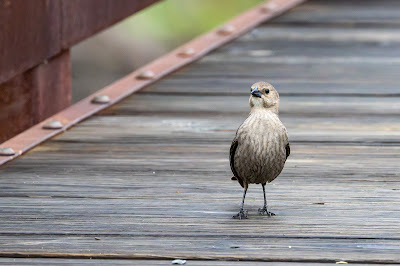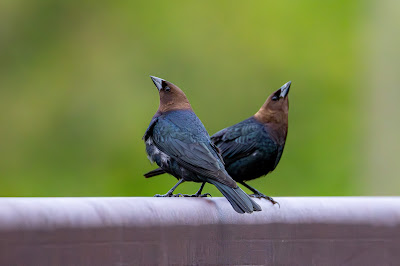At Four-Mile-Run Park, you may notice that bird sounds have
quieted down with the onset of hot summer weather. By now, many migratory
songbirds from the tropics, such as yellow and blackpoll warblers, have headed south
after fledging single nests. They’re getting a leg up (wing up!) on their long
journeys to Central and South America.
But the year-round residents are still breeding during July.
Watch and listen for nests with squeaky broods of sparrow hatchlings, thumb-sized
broken American robins’ blue eggshells, or fat, newly fledged grackle nestlings
poking around on the ground.
If you see an extra-large egg or hatchling in a nest, you’re witnessing parasitism in action. Spot evidence of a parasite:
 |
Brown-headed cowbird egg in black-capped vireo nest in Oklahoma. Photo Credit: Christine
Fallon/USFWS. |
 |
Brown-headed cowbird nestling in Kirtland’s warbler nest. Photo Credit: Cassandra Waldrop/USFWS. |
 |
What nest is this cowbird female at 4-Mile-Run scoping out? Photo Credit: Matt Strachan. |
So, the brown-headed cowbirds spotted this month at Four-Mile-Run are likely up to no good, well good for them but not for other bird species. Ameliorating the impacts of cowbirds on the reproduction of native birds has long been a conservation concern, prompting the formation of a North American Cowbird Advisory Council to make recommendations for managing cowbird populations.
Historically, cowbird impacts would have been muted by their movements with bison, but cow herds are fenced in and not migratory. These days, brown-headed cowbirds threaten other bird species as far north as Alaska and south into central Mexico.
 |
| Brown-headed cowbird males spotted at Four-Mile-Run Park. Photo Credit: Matt Strachan. |